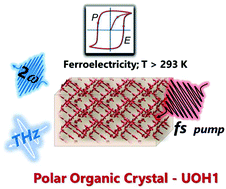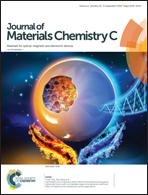Terahertz radiation and second-harmonic generation from a single-component polar organic ferroelectric crystal†
Abstract
A rare single-component polar organic crystal with a distinctive four-fold screw axis is grown from a new dipole molecule, namely 4-(4-(methylthio)phenyl)-2,6-di(1H-pyrazol-1-yl)pyridine (UOH1). The polar molecular ordering is facilitated by a moderate molecular dipole moment (1.42 Debye) and supramolecular (S⋯H–C and N⋯H–C type hydrogen bonding and π–π stacking) interactions. Remarkably, a UOH1 crystal exhibits a ferroelectric hysteresis loop at room temperature without any discontinuity in temperature-dependent dielectric measurements. Additional advantages of this non-centrosymmetric UOH1 crystal are its high second-order nonlinear susceptibility, superior phase matching conditions and low THz absorption. As a result, UOH1 produces both second harmonic and terahertz (THz) waves with ample energy conversion efficiency. These combinations of properties demonstrate the direct technological usefulness of the UOH1 crystal as a non-linear optical and electro-optical material operating at ambient temperature.



 Please wait while we load your content...
Please wait while we load your content...